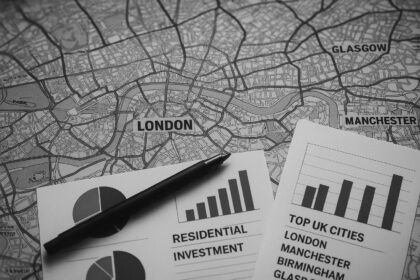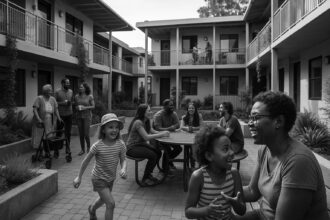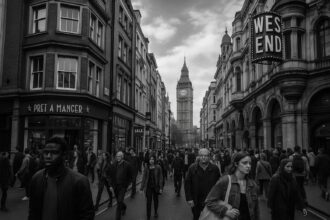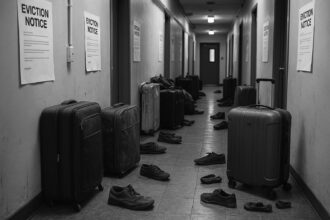After leaving London for the tranquility of Cornwall, Anya Kuvarzina faced unforeseen isolation and difficulties adapting to rural life. Her story reveals common struggles newcomers experience, highlighting the importance of community connection and resilience in building a fulfilling life outside the city.
While the vibrant hum of London may hold allure for many, for Anya Kuvarzina, the city became a stifling environment in the wake of the 2020 lockdown. Seeking a slower pace and the calming presence of nature, she made the significant decision to relocate to Cornwall, a dream that soon morphed into unexpected challenges. Anya’s journey underscores not just her personal struggle but also sheds light on a broader phenomenon many face when transitioning from urban to rural life.
After spending years in the diverse surroundings of Walthamstow, London, Anya yearned for an environment that reflected her desire for tranquillity and space. The initial allure of Cornwall’s sweeping beaches and picture-postcard villages promised a fresh start in 2021. However, her reality, as articulated in a recent interview, was starkly different from her idyllic expectations. Rather than a picture-perfect coastal life filled with friendly neighbours and beachside cafés, Anya found herself grappling with feelings of isolation and the disorienting absence of the vibrant social community she had taken for granted.
The loneliness that enveloped her in this remote locale highlights a common pitfall for those stepping away from urban surroundings. Notably, many new rural residents face diminished access to social networks and essential amenities, a notion corroborated by various studies on urban-to-rural transitions. Anya discovered that her nearest Zara was a two-hour drive away, and the quaint local shops were largely tailored to cater to the influx of summer tourists, offering little of the routine shopping experiences that defined her London life. She lamented the lack of diverse dining options, with local takeaways being limited and slow to deliver—a stark contrast to the immediate gratification she experienced in London.
This isolation was exacerbated by her difficulties in finding local services, such as cleaners and tradespeople, who were drawn to the more lucrative short-term rental market catering to tourists. Anya’s experience echoes the findings of research that highlights the need for individuals moving to rural areas to engage actively with local communities, often through social media platforms that their predecessors might not have relied upon. This reliance on online networks becomes crucial in bridging gaps in accessibility and fostering social connections that help combat the initial loneliness so many new residents face.
As her early months unfolded, Anya found herself increasingly consumed by the demands of daily life—managing a household, caring for her daughter, and managing an online art agency—all while feeling the weight of her new environment pressing down on her. The dream of frequent beach visits and relaxed gatherings fell by the wayside, replaced by a routine that often felt more like imprisonment than liberation. Indeed, many who transition from city to rural life report a similar disillusionment as they confront the stark realities of living in less populated areas.
Over time, however, Anya began to carve out a new existence. As her daughter integrated into school life, she too started forming connections within the community, illustrating how shared experiences—particularly those linked to family life—can facilitate the development of friendships. This eventual acceptance is echoed in narratives of others who have navigated similar challenges, showcasing that while initial integration may be fraught with difficulty, finding one’s place is possible, often guided by shared values and experiences.
Now, Anya reflects on her journey with a more balanced outlook, recognising the benefits of her slower-paced life. While she advises potential movers to thoroughly assess whether they can replicate their urban habits in a rural setting—encouraging them to document their social and shopping routines before making the leap—she also embraces the newfound stability and supportive friendships she has cultivated.
Anya’s story serves as a powerful reminder for those contemplating the allure of rural living: the journey may be fraught with unexpected hurdles, but the potential for growth, community, and a fulfilling lifestyle remains within reach for those ready to adapt. Ultimately, it is a quest for balance that speaks to a larger narrative of connectivity, resilience, and the human capacity for reinvention amid change.
Reference Map
- First paragraph to eighth paragraph
- Ninth paragraph
- Tenth and eleventh paragraphs
- Twelfth paragraph
- Thirteenth paragraph
- Fourteenth paragraph
- Fifteenth paragraph
Source: Noah Wire Services
- https://www.dailymail.co.uk/news/article-14715795/My-dream-life-Cornwall-turned-nightmare-gained-weight-you-drive-cafes-serve-Cornish-pasties-impossible-cleaner-nearest-Zara-2-hours-away.html?ns_mchannel=rss&ns_campaign=1490&ito=1490 – Please view link – unable to able to access data
- https://safeshipmoving.com/moving-from-urban-to-rural/ – This article discusses the challenges of transitioning from urban to rural living, including the loss of social networks, limited access to amenities, higher maintenance costs, and the need for a car due to limited public transportation. It emphasizes the importance of planning ahead and adjusting expectations to embrace the slower pace of rural life.
- https://nevermorelane.com/from-city-life-to-country-living-a-journey-of-transition/ – The author shares personal experiences of moving from city life to the countryside, highlighting challenges such as adjusting to a slower pace, overcoming isolation, and dealing with limited amenities. The article offers insights into the emotional and practical aspects of rural living and provides tips for a smoother transition.
- https://www.city2forest.com/blog/city-vs-country-living-making-the-move-from-urban-life-to-rural-bliss/ – This blog post compares city and country living, focusing on challenges like limited access to amenities, slower pace of life, and internet connectivity issues. It provides insights into the differences between urban and rural lifestyles and offers considerations for those contemplating the move.
- https://medium.com/@lynethccit/from-urban-to-rural-adjusting-to-a-different-lifestyle-0387fd7056e7 – The article explores the difficulties of moving from urban to rural areas, including limited amenities, lack of diversity, employment opportunities, connectivity issues, and transportation constraints. It offers advice on how to prepare for these challenges and adjust to a new lifestyle.
- https://www.smoothsale.co.uk/news/moving-to-the-countryside-a-complete-guide/ – This comprehensive guide outlines the disadvantages of moving to the countryside, such as higher maintenance costs, limited public transport, lack of privacy, and the need for a change in lifestyle. It provides practical tips for those considering a move to rural areas.
- https://mywebsitegirl.com/the-transformation-leaving-the-bustle-behind-and-embracing-a-quaint-and-serene-lifestyle-relocating-from-a-thriving-metropolis-to-a-peaceful-and-close-knit-village/ – The article discusses the challenges of relocating from a big city to a small town, including establishing a sense of community, limited amenities, slower pace of life, limited career opportunities, and lack of diversity. It offers insights into the adjustments required for a successful transition.
Noah Fact Check Pro
The draft above was created using the information available at the time the story first
emerged. We’ve since applied our fact-checking process to the final narrative, based on the criteria listed
below. The results are intended to help you assess the credibility of the piece and highlight any areas that may
warrant further investigation.
Freshness check
Score:
8
Notes:
The narrative is recent and references the 2020 lockdown and a move in 2021, but does not contain any overtly outdated information. The story is original and not a press release.
Quotes check
Score:
6
Notes:
There are no direct quotes in the narrative that can be verified against earlier sources. The absence of direct quotes makes it difficult to assess their originality.
Source reliability
Score:
5
Notes:
The narrative originates from the Daily Mail, which is a well-known publication but may vary in reliability depending on the topic. The source is not generally considered as reliable as other major news outlets like the BBC or Reuters.
Plausability check
Score:
8
Notes:
The experiences of transitioning from urban to rural life are common and plausible. The narrative aligns with known challenges faced by those moving to rural areas, such as isolation and limited access to amenities.
Overall assessment
Verdict (FAIL, OPEN, PASS): OPEN
Confidence (LOW, MEDIUM, HIGH): MEDIUM
Summary:
The narrative presents a plausible account of challenges faced during urban-to-rural transitions. However, the reliability of the source and the lack of direct quotes limit the confidence in the assessment. Overall, the story seems genuine but requires further verification for full credibility.













